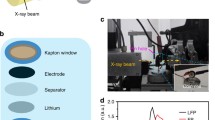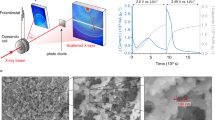Abstract
Operando energy-dispersive x-ray diffraction (EDXRD) was carried out on a newly formed 8 Ah lithium iron phosphate (LiFePO4) battery with the goal of elucidating the origin of asynchronous phase transformation commonly seen with in situ x-ray diffraction studies. The high-energy photons at the NSLS X17B1 beamline allow for penetration into a fully assembled battery and therefore negate any need for a specially designed in situ cell which often uses modified current collectors to minimize x-ray attenuation. Spatially-and-temporally resolved phase-mapping was conducted with a semiquantitative reference intensity ratio (RIR) analysis to estimate the relative abundance of the delithiated phase. The data show an asynchronous response in the stoichiometry versus the electrochemical profile and suggest limited diffusion in the electrode toward the end of discharge. Our results confirm that the asynchronous electrode response is not just limited to specially designed cells but occurs in fully assembled cells alike. We attribute this behavior to be a consequence of performing a local measurement over a wide-area heterogeneous reaction.







Similar content being viewed by others
References
M. Armand and J.M. Tarascon: Building better batteries. Nature 451, 652–657 (2008).
B. Scrosati and J. Garche: Lithium batteries: Status, prospects and future. J. Power Sources 195, 2419–2430 (2009).
J.R. Croy, A. Abouimrane, and Z. Zhang: Next-generation lithium-ion batteries: The promise of near-term advancements. MRS Bull. 39(5), 407 (2014).
T.B. Reddy: Linden’s Handbook of Batteries, 4th ed. (McGraw-Hill, New York, 2011).
M. Ebner, F. Marone, M. Stampanoni, and V. Wood: Visualization and quantification of electrochemical and mechanical degradation in Li ion batteries. Science 342(6159), 716–720 (2013).
J.N. Reimers and J.R. Dahn: Electrochemical and in situ x-ray diffraction studies of lithium intercalation in LixCoO2. J. Electrochem. Soc. 139(8), 2091–2097 (1992).
G.G. Amatucci, J.M. Tarascon, and L.C. Klein: CoO2, the end member of the LixCoO2 solid solution. J. Electrochem. Soc. 143(3), 1114–1123 (1996).
M. Morcrette, Y. Chabre, G. Vaughan, G. Amatucci, J-B. Leriche, S. Patoux, C. Masquelier, and J-M. Tarascon: In situ x-ray diffraction techniques as a powerful tool to study battery electrode materials. Electrochim. Acta 47(19), 3137–3149 (2002).
M.A. Rodriguez, D. Ingersolla, S.C. Vogel, and D.J. Williams: Simultaneous in situ neutron diffraction studies of the anode and cathode in a lithium-ion cell. Electrochem. Solid-State Lett. 7(1), A8–A10 (2004).
A.K. Padhi, K.S. Nanjundaswamy, and J.B.D. Goodenough. Phospho-olivines as positive-electrode materials for rechargeable lithium batteries. J. Electrochem. Soc. 144, 1188–1194 (1997).
A. Yamada, S.C. Chung, and K. Hinokuma: Optimized LiFePO4 for lithium battery cathodes. J. Electrochem. Soc. 148, A224 (2001).
S-Y. Chung, J.T. Bloking, and Y-M. Chiang: Electronically conductive phospho-olivines as lithium storage electrodes. Nat. Mater. 1(2), 123–128 (2002).
W-J. Zhang: Structure and performance of LiFePO4 cathode materials: A review. J. Power Sources 196(6), 2962–2970 (2011).
Corey T. Love, Anna Korovina, Christopher J. Patridge, Karen E. Swider-Lyons, Mark E. Twigg, and David E. Ramaker: Review of LiFePO4 phase transition mechanisms and new observations from x-ray absorption spectroscopy. J. Electrochem. Soc. 160(5), A3153–A3161 (2013).
A.S. Andersson, B. Kalska, L. Haggstrom, and J.O. Thomas: Lithium extraction/insertion in LiFePO4: An x-ray diffraction and Mössbauer spectroscopy study. Solid State Ionics 130, 41–52 (2000).
C. Delmas, M. Maccario, L. Croguennec, F. Le Cras, and F. Weill: Lithium deintercalation in LiFePO4 nanoparticles via a domino-cascade model. Nat. Mater. 7, 665–671 (2008).
N. Meethong, Y-H. Kao, M. Tang, H-Y. Huang, W.C. Carter, and Y-M. Chiang: Electrochemically induced phase transformation in nanoscale olivines Li1−xMPO4 (M = Fe, Mn). Chem. Mater. 20, 6189–6198 (2008).
H-H. Chang, C-C. Chang, H-C. Wu, M-H. Yang, H-S. Sheu, and N-L. Wu: Study on dynamics of structural transformation during charge/discharge of LiFePO4 cathode. Electrochem. Commun. 10(2), 335–339 (2008).
H.C. Shin, K.Y. Chung, W.S. Min, D.J. Byun, H. Jang, and B.W. Cho: Asymmetry between charge and discharge during high rate cycling in LiFePO4–In situ x-ray diffraction study. Electrochem. Commun. 10(4), 536–540 (2008).
K. Inoue, S. Fujieda, K. Shinoda, S. Suzuki, and Y. Waseda: Chemical state of iron of LiFePO4 during charge-discharge cycles studied by in-situ x-ray absorption spectroscopy. Mater. Trans. 51(12), 2220–2224 (2010).
J.B. Leriche, S. Hamelet, J. Shu, M. Morcrette, C. Masquelier, G. Ouvrard, M. Zerrouki, P. Soudan, S. Belic, E. Elkaïm, and F. Baudelet: An electrochemical cell for operando study of lithium batteries using synchrotron radiation. J. Electrochem. Soc. 157(5), A606–A610 (2010).
H.C. Shin, K.W. Nam, Y.W. Chang, B.W. Cho, W-S. Yoon, X-Q. Yang, and K.Y. Chung: Comparative studies on C-coated and uncoated LiFePO4 cycling at various rates and temperatures using synchrotron based in situ x-ray diffraction. Electrochim. Acta 56(3), 1182–1189 (2011).
X-J. Wang, C. Jaye, K-W. Nam, B. Zhang, H-Y. Chen, J. Bai, H. Li, X. Huang, D.A. Fischer, and X-Q. Yang: Investigation of the structural changes in Li1−xFePO4 upon charging by synchrotron radiation techniques. J. Mater. Chem. 21, 11406–11411 (2011).
J. Liu, M. Kunz, K. Chen, N. Tamura, and T.J. Richardson: Visualization of charge distribution in a lithium battery electrode. J. Phys. Chem. Lett. 1(14), 2120–2123 (2010).
M. Farkhondeh, M. Safari, M. Pritzker, M. Fowler, Taeyoung Han, Jasmine Wang, and C. Delacourt: Full-range simulation of a commercial LiFePO4 electrode accounting for bulk and surface effects: A comparative analysis. J. Electrochem. Soc. 161(3), A201–A212 (2014).
F. Ronci, B. Scrosati, V. Rossi Albertini, and P. Perfetti: A novel approach to in situ diffractometry of intercalation materials: The EDXD technique preliminary results on LiNi0.8Co0.2O2. Electrochem. Solid-State Lett. 3(4), 174–177 (2000).
S. Panero, P. Reale, F. Ronci, B. Scrosati, P. Perfetti, and V. Rossi Albertini: Refined, in-situ EDXD structural analysis of the Li[Li1/3Ti5/3]O4 electrode under lithium insertion–extraction. Phys. Chem. Chem. Phys. 3, 845–847 (2001).
J. Rijssenbeek, Y. Gao, Z. Zhong, M. Croft, N. Jisrawi, A. Ignatov, and T. Tsakalakos: In situ x-ray diffraction of prototype sodium metal halide cells: Time and space electrochemical profiling. J. Power Sources 196(4), 2332–2339 (2011).
E. Takeuchi, A. Marschilok, K. Takeuchi, A. Ignatov, Z. Zhong, and M. Croft: Energy dispersive x-ray diffraction of lithium–silver vanadium phosphorous oxide cells: In situ cathode depth profiling of an electrochemical reduction–displacement reaction. Energy Environ. Sci. 6, 1465–1470 (2013).
J.W. Gallaway, C.K. Erdonmez, Z. Zhong, M. Croft, L.A. Sviridov, T.Z. Sholklapper, D.E. Turney, S. Banerjee, and D.A. Steingart: Real-time materials evolution visualized within intact cycling alkaline batteries. J. Mater. Chem. A 2, 2757–2764 (2014).
W. Thomlinson, D. Chapman, N. Gmür, and N. Lazarz: The superconducting wiggler beamport at the National Synchrotron Light Source. Nucl. Instrum. Methods A 266, 226–233 (1988).
M. Wojdyr: Fityk: A general-purpose peak fitting program. J. Appl. Crystallogr. 43, 1126–1128 (2010).
F.H. Chung: Quantitative interpretation of x-ray diffraction patterns of mixtures. III. Simultaneous determination of a set of reference intensities. J. Appl. Crystallogr. 8, 17 (1975).
Calculated from FIZ#99861 (09/11/09) by Jade for FePO.
Calculated from FIZ#162282 (09/11/09) by Jade for LiFePO.
ACKNOWLEDGEMENTS
Use of the National Synchrotron Light Source, Brookhaven National Laboratory, was supported by the U.S. Department of Energy, Office of Science, Office of Basic Energy Sciences, under Contract No. DE-AC02-98CH10886.
Author information
Authors and Affiliations
Corresponding author
Rights and permissions
About this article
Cite this article
Paxton, W.A., Akdoğan, E.K., Şavkliyildiz, İ. et al. Asynchronous stoichiometric response in lithium iron phosphate batteries. Journal of Materials Research 30, 417–423 (2015). https://doi.org/10.1557/jmr.2014.321
Received:
Accepted:
Published:
Issue Date:
DOI: https://doi.org/10.1557/jmr.2014.321






